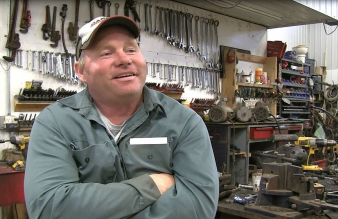Congratulations to Zac Cohoon, who has been announced as the 2017 Innovative Farmer of the Year by the Innovative Farmers Association of Ontario (IFAO). Zac is being celebrated for his practices in adding compost and building soil organic matter on his 1,200 acre farm near Port Perry, in Durham Region. Read more from the IFAO’s story, copied below:
Ontario’s Innovative Farmer of the Year for 2017 is Zac Cohoon, who has been adding compost and building soil organic matter for twenty years on his farm near Port Perry. Every year, the Innovative Farmers Association of Ontario (IFAO) chooses a farmer that exemplifies great soil stewardship, progressive thinking and a curiosity to try new farm practices. Cohoon, like past winners and like many other farmers across the province, is the epitome of innovation.
Cohoon farms 1200 acres with his family in the northern Durham region along Lake Scugog. While they used to be in livestock production, they now focus on cropping and grow a rotation of corn, IP soybeans, oats, wheat and some hay across a diverse range of soil types.
“Our ‘ah ha’ moment was when we ran out of manure,” Cohoon explains. Twenty years ago, he began mixing municipal paper by-products with broiler manure to make a better soil amendment and when they closed the barns for good about a decade ago, they began using composted leaf and yard waste mixed with mushroom compost, paper by- products and a small amount of composted food scraps. He lets the piles dry down undisturbed for a few months on bermed clay pads in the field and applies the compost with a vertical beater spreader onto dry ground after wheat. He then seeds the field to a cover crop to help stabilize the nutrients.
“We’ve been doing this for twenty years now. When we purchased one particular field it was just eroding sand and we couldn’t even produce 10 bushel beans,” says Cohoon. “But with the compost, we are seeing excellent results. Soil organic matter has risen by almost 1 percent and the worm populations are there now. This year we averaged 54 bushels off that field.”
Of course, compost comes with its fair share of issues. Tomatoes, squash and nightshade weeds have been a challenge with his IP soybeans. The weight of the spreader and product is also an issue. “Compaction from the spreading equipment can be just as detrimental as not using the material at all,” Cohoon says. That is why he spreads compost only on his sandy soils and only when the conditions are just right.
As for how he made out in the drought conditions of 2016, Cohoon says he was surprised. “Where we thought we would have the most issues was on the sandier soils, but that’s also where we put our compost down so it’s actually where the drought had the least impact,” he says.
Cohoon was nominated by Matt Porter, his agronomist and a family friend. “Zac is innovative because he wakes up every day and doesn’t do the same thing,” says Porter. “Every time we do something, we evaluate, discuss, look at success and failures and learn from that.”
Last year, the pair tried broadcasting winter wheat after soybeans and lightly incorporating the seed with a Lemken high speed disc. Porter claims that wheat grows better when it isn’t in rows and the root network better protects the soil from compaction and rutting when applying early season nitrogen.
As they continue to tweak his soil fertility and improve soil health, Cohoon’s next frontier is land management. He is working on contour farming, improving drainage and adding hedgerows back in the right places to create warmer microclimates. “That’s especially important here, where we’re dealing with topography and lower heat units,” he explains.
He is also experimenting with precision tools, but isn’t entirely convinced that the high-tech solutions are going to improve his bottom line. “I think you’re better off taking the highs and lows out of your field than trying to adjust the fertilizer or seeding rate to do that,” he says.
“We’ve gone outside of the box by using compost to create soil amendments, but we’re not looking at huge fertility nutrients here. We’re really looking at natural nutrients, biodiversity, organic matter and long term soil stability. We take soil samples and we use as little fertilizer as we need in order to make a crop. Is that innovative? That’s just cost effective,” Cohoon explains.
Like most innovators, Cohoon says it is simply a matter of necessity. “Every once in a while we have a rock star moment, but I don’t feel like any great innovator. Idea maker, mechanic, fixer, sure, but not an innovator,” he laughs.
“I farm for my children,” Cohoon continues. “The way I see it is I am renting my land and my business from my children and I’m producing a resource for them to use in their adulthood, and hopefully for their next generation as well.”
The Innovative Farmer of the Year award will be presented at the IFAO Conference, February 21-22, 2017 in London. More details at www.ifao.com.

